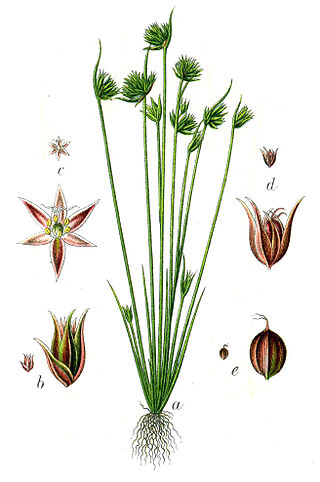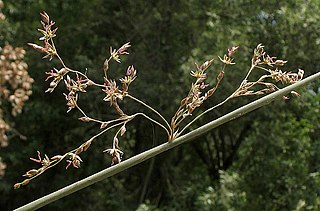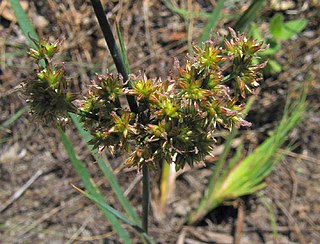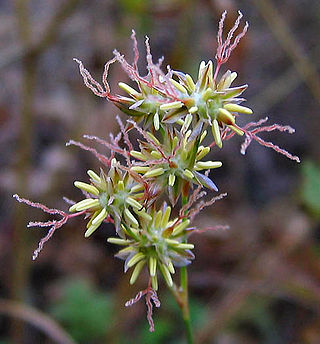
Juncaceae is a family of flowering plants, commonly known as the rush family. It consists of 8 genera and about 464 known species of slow-growing, rhizomatous, herbaceous monocotyledonous plants that may superficially resemble grasses and sedges. They often grow on infertile soils in a wide range of moisture conditions. The best-known and largest genus is Juncus. Most of the Juncus species grow exclusively in wetland habitats. A few rushes, such as Juncus bufonius are annuals, but most are perennials.

Juncus bufonius, known commonly as toad rush, is a widespread flowering plant species complex in the rush family Juncaceae.

Juncus articulatus is a flowering plant species in the rush family Juncaceae. It is known by the common name jointleaf rush or jointed rush, which can also refer to J. kraussii from Australia. It is native to Eurasia, Canada, Greenland, and much of the United States. It grows in moist areas, such as wet sand, and thrives in calcareous soils. J. articulatus was found to be more sensitive to drought and salt stress than its congeners J. acutus and J. maritimus. It is a perennial herb producing mainly erect stems from a short rhizome. The stem may root at nodes, and it generally has one or more flattened hollow cylindrical leaves up to 10 centimeters long. Transverse internal partitions or joints may be seen or felt in the leaf of the plant.

Juncus capitatus is a species of rush known by the common names dwarf rush and leafybract dwarf rush. It is native to Europe, Asia and North Africa. It is also an introduced species in parts of North America such as California and the Gulf Coast. It grows in moist areas, such as wet sand, vernal pools, and ditches.

Juncus drummondii is a species of rush known by the common name Drummond's rush. It is native to western North America from northern Canada and Alaska to New Mexico, where it grows in wet coniferous forest and alpine meadows and slopes. This is a perennial herb forming narrow, erect tufts to about 40 centimeters in maximum height. The leaves are basal and most have no real blades; instead they form a sheath around the stem a few centimeters long. The inflorescence is borne on the side of the stem toward the top. There is a long, cylindrical bract at the base which extends out past the flowers. Each flower is on a thin pedicel. The thick tepals are dark brown, sometimes with green striping and thin, transparent edges. There are six stamens with yellowish anthers, and red stigmas. The fruit is a capsule.

Juncus mexicanus is a species of rush known by the common name Mexican rush. It is native to the southwestern quadrant of the United States and parts of Mexico and Central and South America. It is a plant of moist areas in a great number of habitats, from coast to desert to mountain and low to high elevation.

Juncus patens is a species of rush, known by the common names spreading rush and California grey rush.

Juncus dubius is a species of rush known by the common name wrinkled rush. It is endemic to California, in the California Coast Ranges, Transverse Ranges, and southern Sierra Nevada. It is a common member of the flora in many wet areas, such as marshes and riverbanks.

Juncus textilis is a species of rush known by the common name basket rush. It is endemic to California, where it grows along the coast and in the coastal mountain ranges of the southern half of the state.

Juncus xiphioides is a species of rush known by the common name irisleaf rush.
Juncus bryoides is a species of rush known by the common names moss rush and mosslike dwarf rush. It is native to western North America from Oregon to Baja California, where it grows in many types of wet, sandy habitat. It is a very tiny annual herb producing erect, hair-thin stems no more than about 2 centimeters tall. Atop the stem is one flower made up of a few reddish segments 1 to 3 millimeters long which curve around the developing fruit.
Juncus hemiendytus is a species of rush known by the common name Herman's dwarf rush. It is native to the western United States, where it grows in moist places, especially areas that are wet in spring, such as vernal pools. This is a very small annual herb forming dense clumps of hair-thin reddish stems no more than about 3 centimeters tall. The tiny, thready leaves surrounding the stems are up to about 2 centimeters long. Each stem usually bears one reddish flower, which is made up of segments 2 or 3 millimeters long curving around the developing fruit.
Juncus kelloggii is a species of rush known by the common name Kellogg's dwarf rush. It is native to western North America from British Columbia to California, where it grows in low, wet spots in meadows and other grassy areas, for example, vernal pools.
Juncus leiospermus is an uncommon species of rush known by the common name Red Bluff dwarf rush. It is endemic to California, where it is known only from the Central Valley and adjacent Sierra Nevada foothills to the east.

Juncus macrophyllus is a species of rush known by the common name longleaf rush.
Juncus tiehmii is a species of rush known by the common name Nevada rush. It is native to the western United States, where it grows in wet habitat with granite sand substrate, including riverbanks and barren seeps. This is a small annual herb forming dense clumps of hair-thin stems no more than about 6 centimeters high. The inflorescence is made up of one to seven tiny flowers atop each stem. The flowers have a few greenish to pink or red segments no more than about 3 millimeters long.
Juncus uncialis is a species of rush known by the common names twelfth rush and inch-high rush. It is native to the western United States, where it is known from wet habitat such as vernal pools. This is a petite annual herb forming dense clumps of hair-thin green stems no more than 3 or 4 centimeters high. The inflorescence is made up of a single tiny flower atop each stem. The flower has several reddish segments about 2 to 5 millimeters long wrapped around the developing fruit.
Juncus digitatus is a rare species of rush known by the common name finger rush. It is endemic to Shasta County, California, where it is known from only two occurrences near Shingletown. It occurs in spring-moist habitat such as vernal pools in sunny locations in the foothills of the southernmost Cascade Range. The plant was first collected in 1991 and described to science as a new species in 2008.

Juncus phaeocephalus, the brown-headed rush, is native mostly along the coast of California, north to Oregon and Washington. It grows in moist seeps and shallow wet soil.

Juncus luciensis is a species of rush known by the common name Santa Lucia dwarf rush. It is endemic to California, where it is uncommon.













